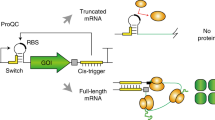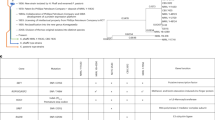Abstract
Structural proteomics requires robust, scalable methods. Here we describe a wheat germ cell-free platform for protein production that supports efficient NMR structural studies of eukaryotic proteins and offers advantages over cell-based methods. To illustrate this platform, we describe its application to a specific target (At3g01050.1) from Arabidopsis thaliana. After cloning the target gene into a specialized plasmid, we carry out a small-scale (50 μl) in vitro sequential transcription and translation trial to ascertain the level of protein production and solubility. Next, we prepare mRNA for use in a 4-ml semicontinuous cell-free translation reaction to incorporate 15N-labeled amino acids into a protein sample that we purify and test for suitability for NMR structural analysis. We then repeat the cell-free approach with 13C,15N-labeled amino acids to prepare a doubly labeled sample. The three-dimensional (3D) structure of At3g01050.1 shows that this protein is an unusual member of the β-grasp protein family.
This is a preview of subscription content, access via your institution
Access options
Subscribe to this journal
Receive 12 print issues and online access
$259.00 per year
only $21.58 per issue
Buy this article
- Purchase on Springer Link
- Instant access to full article PDF
Prices may be subject to local taxes which are calculated during checkout



Similar content being viewed by others
References
Kramer, G., Kudlicki, W. & Hardesty, B. Cell-free coupled transcription-translation systems from Escherichia coli. in Protein Expression. A Practical Approach (eds. Higgens, S.J. & Hames, B.D.) 201–223 (Oxford Univ. Press, Oxford, UK, 1999).
Clemens, M.M. & Prujin, G.J. Protein synthesis in eukaryotic cell-free systems. in Protein Expression. A Practical Approach (eds. Higgens, S.J. & Hames, B.D.) 129–165 (Oxford Univ. Press, Oxford, UK, 1999).
Cubeddu, L. et al. Dictyostelium discoideum as expression host: isotopic labeling of a recombinant glycoprotein for NMR studies. Protein Expr. Purif. 19, 335–342 (2000).
Strauss, A. et al. Amino-acid-type selective isotope labeling of proteins expressed in Baculovirus-infected insect cells useful for NMR studies. J. Biomol. NMR 26, 367–372 (2003).
Bruggert, M., Rehm, T., Shanker, S., Georgescu, J. & Holak, T.A. A novel medium for expression of proteins selectively labeled with 15N-amino acids in Spodoptera frugiperda (Sf9) insect cells. J. Biomol. NMR 25, 335–348 (2003).
Goff, S.A. & Goldberg, A.L. An increased content of protease LA, the Lon gene product, increases protein degradation and blocks growth in Escherichia coli. J. Biol. Chem. 262, 4508–4515 (1987).
Maurizi, M.R. Degradation in vitro of bacteriophage λ N protein by Lon protease from Escherichia coli. J. Biol. Chem. 262, 2696–2703 (1987).
Chrunyk, B.A., Evans, J., Lillquist, J., Young, P. & Wetzel, R. Inclusion-body formation and protein stability in sequence variants of interleukin-1β. J. Biol. Chem. 268, 18053–18061 (1993).
Shi, J., Pelton, J.G., Cho, H.S. & Wemmer, D.E. Protein signal assignments using specific labeling and cell-free synthesis. J. Biomol. NMR 28, 235–247 (2004).
Torizawa, T., Terauchi, T. & Kainosho, M. [Recent developments in NMR methods for structural biology]. Seikagaku 74, 1279–1284 (2002).
Kigawa, T., Muto, Y. & Yokoyama, S. Cell-free synthesis and amino acid-selective stable isotope labeling of proteins for NMR analysis. J. Biomol. NMR 6, 129–134 (1995).
Yabuki, T. et al. Dual amino acid-selective and site-directed stable-isotope labeling of the human c-Ha-Ras protein by cell-free synthesis. J. Biomol. NMR 11, 295–306 (1998).
Klammt, C. et al. High level cell-free expression and specific labeling of integral membrane proteins. Eur. J. Biochem. 271, 568–580 (2004).
Henrich, B., Lubitz, W. & Plapp, R. Lysis of Escherichia coli by induction of cloned φX174 genes. Mol. Gen. Genet. 185, 493–497 (1982).
Guignard, L., Ozawa, K., Pursglove, S.E., Otting, G. & Dixon, N.E. NMR analysis of in vitro–synthesized proteins without purification: a high-throughput approach. FEBS Lett. 524, 159–162 (2002).
Kigawa, T. & Yokoyama, S. [High-throughput cell-free protein expression system for structural genomics and proteomics studies]. Tanpakushitsu Kakusan Koso 47, 1014–1019 (2002).
Kigawa, T. et al. Cell-free production and stable-isotope labeling of milligram quantities of proteins. FEBS Lett. 442, 15–19 (1999).
Kim, D.M., Kigawa, T., Choi, C.Y. & Yokoyama, S. A highly efficient cell-free protein synthesis system from Escherichia coli. Eur. J. Biochem. 239, 881–886 (1996).
Yokoyama, S. Protein expression systems for structural genomics and proteomics. Curr. Opin. Chem. Biol. 7, 39–43 (2003).
Yokoyama, S. et al. Structural genomics projects in Japan. Nat. Struct. Biol. 7, 943–945 (2000).
Kim, D.M. & Swartz, J.R. Prolonging cell-free protein synthesis by selective reagent additions. Biotechnol. Prog. 16, 385–390 (2000).
Yin, G. & Swartz, J.R. Enhancing multiple disulfide bonded protein folding in a cell-free system. Biotechnol. Bioeng. 86, 188–195 (2004).
Chumpolkulwong, N. et al. Effects of Escherichia coli ribosomal protein S12 mutations on cell-free protein synthesis. Eur. J. Biochem. 271, 1127–1134 (2004).
Kawasaki, T., Gouda, M.D., Sawasaki, T., Takai, K. & Endo, Y. Efficient synthesis of a disulfide-containing protein through a batch cell-free system from wheat germ. Eur. J. Biochem. 270, 4780–4786 (2003).
Madin, K., Sawasaki, T., Ogasawara, T. & Endo, Y. A highly efficient and robust cell-free protein synthesis system prepared from wheat embryos: plants apparently contain a suicide system directed at ribosomes. Proc. Natl. Acad. Sci. USA 97, 559–564 (2000).
Morita, E.H., Sawasaki, T., Tanaka, R., Endo, Y. & Kohno, T. A wheat germ cell-free system is a novel way to screen protein folding and function. Protein Sci. 12, 1216–1221 (2003).
Sawasaki, T. et al. A bilayer cell-free protein synthesis system for high-throughput screening of gene products. FEBS Lett. 514, 102–105 (2002).
Sawasaki, T., Ogasawara, T., Morishita, R. & Endo, Y. A cell-free protein synthesis system for high-throughput proteomics. Proc. Natl. Acad. Sci. USA 99, 14652–14657 (2002).
Betton, J.M. Rapid translation system (RTS): a promising alternative for recombinant protein production. Curr. Protein Pept. Sci. 4, 73–80 (2003).
Altieri, A.S., Hinton, D.P. & Byrd, R.A. Association of biomolecular systems via pulsed field gradient NMR self-diffusion measurements. J. Am. Chem. Soc. 117, 7566–7567 (1995).
Bartels, C., Billeter, M., Güntert, P. & Wüthrich, K. Automated sequence-specific NMR assignment of homologous proteins using the program GARANT. J. Biomol. NMR 7, 207–213 (1996).
Herrmann, T., Guntert, P. & Wuthrich, K. Protein NMR structure determination with automated NOE assignment using the new software CANDID and the torsion angle dynamics algorithm DYANA. J. Mol. Biol. 319, 209–227 (2002).
Linge, J.P., Williams, M.A., Spronk, C.A., Bonvin, A.M. & Nilges, M. Refinement of protein structures in explicit solvent. Proteins 50, 496–506 (2003).
Palmer III, A.G. NMR probes of molecular dynamics: overview and comparison with other techniques. Annu. Rev. Biophys. Biomol. Struct. 30, 129–155 (2001).
Terauchi, T., Ohki, S.Y. & Kainosho, M. [Developing a new approach for high-throughput, high-accuracy NMR structural analyses of genomic proteins]. Tanpakushitsu Kakusan Koso 47, 1045–1051 (2002).
Larsen, C.N. & Wang, H. The ubiquitin superfamily: members, features, and phylogenies. J. Proteome Res. 1, 411–419 (2002).
Grynberg, M., Jaroszewski, L. & Godzik, A. Domain analysis of the tubulin cofactor system: a model for tubulin folding and dimerization. BMC Bioinformatics 4, 46 (2003).
Delaglio, F. et al. NMRPIPE—a multidimensional spectral processing system based on UNIX pipes. J. Biomol. NMR 6, 277–293 (1995).
Cornilescu, G., Delaglio, F. & Bax, A. Protein backbone angle restraints from searching a database for chemical shift and sequence homology. J. Biomol. NMR 13, 289–302 (1999).
Laskowski, R.A., MacArthur, M.W., Moss, D.S. & Thornton, J.M. PROCHECK: a program to check the stereochemical quality of protein structures. J. Appl. Crystallogr. 26, 283–291 (1993).
Hooft, R.W.W., Vriend, G., Sander, C. & Abola, E.E. Errors in protein structures. Nature 381, 272 (1996).
Acknowledgements
We thank Y. Endo and CellFree Sciences Co., Ltd., for advice and encouragement in using the wheat germ cell-free system that they have developed; and M. Kainosho for sharing the unpublished information cited here. This research was supported by a grant from the National Institutes of Health Protein Structure Initiative (1 P50 GM64598 to J.L.M.).
Author information
Authors and Affiliations
Corresponding author
Ethics declarations
Competing interests
As stated in the article, the Center for Eukaryotic Structural Genomics and the University of Wisconsin–Madison have a collaborative agreement with Ehime University and Cell-Free Sciences, Co. Ltd., a company located in Yokohama, Japan. Under the terms of this agreement, the parties involved are codeveloping and improving the wheat germ cell-free technology. Discussions are ongoing concerning the establishment of a US company to further develop and commercialize this technology; this company might involve certain authors of this paper (D.A.V. and J.L.M.).
Supplementary information
Rights and permissions
About this article
Cite this article
Vinarov, D., Lytle, B., Peterson, F. et al. Cell-free protein production and labeling protocol for NMR-based structural proteomics. Nat Methods 1, 149–153 (2004). https://doi.org/10.1038/nmeth716
Received:
Accepted:
Published:
Issue Date:
DOI: https://doi.org/10.1038/nmeth716
This article is cited by
-
Protein structural biology using cell-free platform from wheat germ
Advanced Structural and Chemical Imaging (2018)
-
A MUB E2 structure reveals E1 selectivity between cognate ubiquitin E2s in eukaryotes
Nature Communications (2016)
-
Cell-free expression, purification, and membrane reconstitution for NMR studies of the nonstructural protein 4B from hepatitis C virus
Journal of Biomolecular NMR (2016)
-
Expression platforms for producing eukaryotic proteins: a comparison of E. coli cell-based and wheat germ cell-free synthesis, affinity and solubility tags, and cloning strategies
Journal of Structural and Functional Genomics (2015)
-
PSI:Biology-materials repository: a biologist’s resource for protein expression plasmids
Journal of Structural and Functional Genomics (2011)



